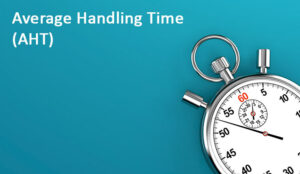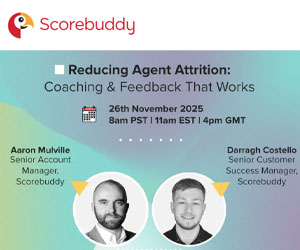We have a dual chat window, so my question is – how do you calculate Average Handling Time in a dual chat?
Question asked by vikram
Calculating AHT for Concurrent Chat Handling
When calculating Average Handling Time (AHT) for chat with concurrency (handling multiple chats at the same time), the standard AHT formula needs to account for the fact that agents are multitasking.
The formula changes because handling concurrent chats requires distributing the total handling time across multiple interactions.
Standard AHT Formula for Single Chats:
AHT = Total Handling Time (THT) ÷ Number of Chats Handled
In concurrent (dual or multi-chat) scenarios, we need to adjust for concurrency, which is the number of chats handled simultaneously. Here’s how to do it.
Steps to Calculate AHT for Concurrent Chats
1. Total Handling Time (THT)
This is the time the agent spends actively working on chats, including the chat duration plus after-chat work (if any). Importantly, the time is logged as continuous for the agent, even though they are handling multiple chats concurrently
2. Concurrency Factor (C)
This is the average number of chats being handled concurrently. If an agent typically handles 2 chats at once, the concurrency factor is 2
3. The Formula
AHT = (Total Handling Time (THT) ÷ Number of Chats Handled) x (1 ÷ Concurrency Factor)
Example Calculation:
- Total Handling Time (THT): 120 minutes (the total time the agent spent online handling chats in a shift)
- Number of Chats Handled: 30 chats
- Concurrency Factor (C): 2 (since the agent was handling 2 chats simultaneously)
AHT Calculation
AHT = (120 Minutes ÷ 30 Chats) x (1 ÷ 2) = 2 Minutes Per Chat
In this case, the agent’s AHT would be 2 minutes per chat. Without considering concurrency, it would be 4 minutes, but since they are handling two chats at once, the AHT per chat is halved.
Factors to Consider –
- Concurrency Factor: Varies depending on how many chats the agent is handling simultaneously (e.g., dual, triple, or more chats).
- Dynamic Concurrency: If the number of concurrent chats varies throughout the day (sometimes 2, sometimes 3), you can calculate a weighted average concurrency factor based on actual performance during the time period.
By accounting for concurrency, the AHT becomes a more accurate representation of how efficiently an agent handles chat interactions.
Please Note AHT Increases as Concurrency Increases
When an agent is handling multiple chats at the same time, the Average Handling Time (AHT) increases because the agent can only type to one customer at a time.
Here’s a simplified explanation:
- One chat at a time: If the agent is typing a response to Customer 1, they can’t respond to Customer 2 at the same time. This means Customer 2 has to wait until the agent finishes responding to Customer 1.
- Switching between chats: After finishing with Customer 1, the agent switches to Customer 2. But by the time they switch, the conversation with Customer 2 has taken longer than if the agent was only handling one chat.
This back-and-forth switching increases the total time it takes to complete each chat, leading to longer AHT.
Key point:
While an agent might be helping more customers at once, the delay between responses for each customer makes the whole process take longer. This is why handling multiple chats increases the Average Handling Time (AHT) per chat.
Example Table Showing AHT vs Number of Concurrent Chats
| Number of Concurrent Chats | Base AHT per Chat (Minutes) | Adjusted AHT per Chat (Including Delays) | Customer Satisfaction Score (CSAT) |
|---|---|---|---|
| 1 Chat | 3 minutes | 3 minutes | 95% |
| 2 Chat | 3 minutes | 4 minutes | 90% |
| 3 Chat | 3 minutes | 5 minutes | 80% |
| 4 Chat | 3 minutes | 6 minutes | 70% |
| 5 Chat | 3 minutes | 7 minutes | 60% |
Explanation:
- 1 Chat (95% CSAT): With only one chat, the agent can respond quickly, leading to minimal wait times and high customer satisfaction.
- 2 Chats (90% CSAT): As the agent handles two chats, wait times increase slightly, causing a small drop in CSAT.
- 3 Chats (80% CSAT): With three chats, longer delays between responses lead to more noticeable dissatisfaction, reducing the CSAT to 80%.
- 4 Chats (70% CSAT): Handling four chats creates more significant delays, which start to frustrate customers, bringing the CSAT down to 70%.
- 5 Chats (60% CSAT): At this point, customers may experience long response times, resulting in lower satisfaction, with a 60% CSAT.
Please note that this table represents hypothetical data to illustrate the interplay between chat concurrency, Average Handling Time, and Customer Satisfaction Score, and does not reflect actual customer data.
If you’re looking for more ways to calculate common contact centre stats, read these next:
- How to Calculate Required FTE for Inbound Call Volumes
- Staffing Calculator for Email Queues
- The AHT Glide Path (Learning Curve) Calculation
Author: Jonty Pearce
Reviewed by: Hannah Swankie
Published On: 12th Apr 2022 - Last modified: 3rd Oct 2025
Read more about - Call Centre Questions, Average Handling Time (AHT), Call Centre Answers





































